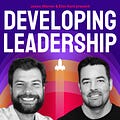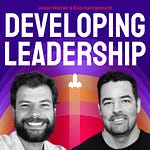Jason and Eiso explore the intersection between finance and engineering leadership and discuss the importance of position sizing in engineering orgs. From promotions to product initiatives and technology choices, leaders are constantly making bets. So the guys delve into decision making, risk management, trust, and the dangers of placing the wrong bets.
💬 A few of our favorite moments from the chat
Ultimately I think people and technology are the ones that will stop all companies from becoming generational companies.
I think that we don't do enough actual real company building anymore. Going back to the analogy of the Cruise Ship versus the Flotilla, ****it’s like, "Hey, we're actually company building here for multiple decades." not “we're product building for a quarter.” I want executives to switch into that mindset of company building.
One of the things that you might notice in some of the older, larger, organizations that are "innovating," - and AI as an example of this, - they're taking multi-year approaches to some of these things. And obviously there's some benefit to long research in some domains, but there shouldn't be multiple years to show some obvious value prop.
I have always tried to be very transparent that I make decisions based upon trust. And for me, if I'm going to choose where something is going to go sit, even if it's just application engineering, data engineering, infrastructure engineering, and a platform engineering, it's gonna be a logical decision and a trust-based decision.
And trust is, "Who do I think will do the best job with this? Who do I think will achieve the best outcome?" All that sort of stuff. And I try to be really transparent with it and I try to be approachable with someone else calling me on my BS as well.
But at the end of the day, what you're effectively trying to go do is you're saying, "I'm handing this off to somebody else. I trust this person to go do this." And the flip side of saying, "Hey, I trust this person to go do this," could be, "I trust this other person much less to go do this."
I don't think I've ever fired faster than when someone has broken trust. And it's always been about some sort of undermining, Machiavellian thing. There's been multiple times where someone has thought they should have my job or something like that. And I've actually put up with some of those situations because I thought I was coaching a person, but I've never fired faster than when it was them trying to undermine a peer and take over a peer's thing.
💡 Topic Explainers
🚢 The Flotilla vs The Cruise Ship
Jason uses the analogy of a cruise ship versus a flotilla to describe his ideal way of building and operating companies. 👉 He believes that organizations are not monolithic structures and that thinking of them as one monolithic entity, like a cruise ship, can be limiting.
A cruise ship is one large, unified structure that moves in one direction at one speed, much like a traditional company.
Instead, Jason prefers to think of a company as a flotilla, which is an armada of ships working towards one mission with one ultimate captain giving overall orders.
Each ship has a specialty and understands what it needs to do in the context of the overall mission. In this way, each ship can move independently while contributing to the success of the mission as a whole.
In an ideal state, companies should function in a similar way to a flotilla, with each team understanding their role and contributing to the overall success of the company.
This approach allows for greater flexibility and adaptability, as well as a better alignment with the overall mission. Jason believes that thinking of companies as cruise ships can lead to a rigid, inflexible structure that may not be able to adapt to changing circumstances.
💌 Jason’s Microservices Twitter Thread

💡 Position sizing
Jason and Eiso discuss "position sizing" in relation to the risks leaders are willing to take when starting new projects and considering finances.
👉 Position sizing refers to the process of determining the appropriate amount of work for a team or individual to take on for a specific project or sprint.
When it comes to new projects and finances, leaders must consider the risks involved and the resources available before deciding on the appropriate size of the project team and the amount of work they should take on.
Thinking about position sizing can help leaders can make informed decisions about the risks they are willing to take and optimize their use of available resources.
💡 Eleanor Roosevelt Quote
The Eleanor Roosevelt quote Jason refers to, is: "Great minds discuss ideas; average minds discuss events; small minds discuss people.”
Watch this episode YouTube > https://youtu.be/tYtA4FF1WG8
Join the discussion and follow us on twitter @devleadership_
Developing Leadership is powered by Athenian. We are introducing a winning approach to engineering metrics that can help you empower your teams to autonomously improve. If you want to learn more, go to athenian.com














Placing Bets & Building Trust as an Engineering Leader